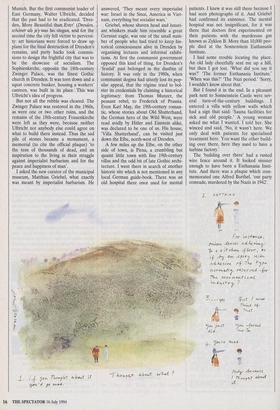LOOKING BAGK I ;M•1:1-4E
HORROR OF THE PAST
Ian Buruma visited Dresden, and was shocked
by the act of perversity which smashed the accumulated beauty of centuries
THE QUEEN MOTHER has always stood by Arthur 'Bomber' Harris. As patron of the Bomber Command Associa- tion it is only proper that she should. Oth- ers might feel less enthusiasm for the man who, in the words of one of his pilots, had 'a great weakness for government fire- works'. The forthcoming television docu- mentary on 'Bomber' or 'Butcher' Harris, to be broadcast by Channel 4 next month, will doubtless set off the great Bomber debate once again.
I visited Dresden at the time of the last controversy, in 1992, when the Queen Mother unveiled a statue of the Bomber outside the RAF church of St Clement Dane's in the Strand. It was impossible not to be moved by what I saw. I thought of Walter Benjamin's metaphor of history, inspired by a painting by Paul Klee. It is of an angel who looks back in horror at the past. History is like 'one single catastrophe which keeps piling ruin upon ruin and hurls it in front of his feet'. The angel would like to make whole what was smashed. But he can't, for he is propelled forward into the future, to which his back is turned, while the pile of debris before him grows ever higher. 'The storm is what we call progress.'
The idea of progress, as well as British bombs, turned Dresden into a city of ruins and monstrosities. Walking through the 'What's all this about you scoria' my Miss us?' hideous streets of central Dresden, seeing the few bits and pieces of the old city, like fragments of a beautiful antique jar, pro- duced in me an irrational feeling of guilt by association. This sensation was not espe- cially noble. It was not so much the victims that I had in mind. What is so shocking about the bombing of Dresden is that it smashed in one night the accumulated beauty of centuries. Dresden, like Prague or Venice, was one of the architectural wonders of the world. Its destruction was an act of perversity, like putting an axe to a Chippendale chair, or knifing a Michelan- gelo, or burning a priceless library. It was all the more perverse since there was no compelling strategic reason for it. Which is not to say that the bombing of ugly slums is any less ghastly, in human terms, than the destruction of Dresden's baroque heart. It's just that being in the new, empty hole of Dresden, where there once was a heart, is to be constantly aware of what was lost.
Parts of the old city could have been saved after the war. Enough was left of some of the palaces and churches to make restoration feasible, as in Nuremberg or Munich. But the first communist leader of East Germany, Walter Ulbricht, decided that the past had to be eradicated. 'Dres- den, More Beautiful. than Ever' (Dresden, schoner als je) was his slogan, and for the second time the city fell victim to perversi- ty: art historians were forced to draw up plans for the final destruction of Dresden's remains, and party hacks took commis- sions to design the frightful city that was to be the showcase of socialism. The Sophienlcirche, opposite the 18th-century Zwinger Palace, was the finest Gothic church in Dresden. It was torn down and a squat concrete bunker, housing a workers' canteen, was built in its place. This was Ulbricht's idea of progress.
But not all the rubble was cleared. The Zwinger Palace was restored in the 1960s, as were one or two other ruins, and the remains of the 18th-century Frauenkirche were left as they were, because neither Ulbricht nor anybody else could agree on what to build there instead. Thus the sad pile of stones became a monument, a memorial (to cite the official plaque) 'to the tens of thousands of dead, and an inspiration to the living in their struggle against imperialist barbarism and for the peace and happiness of man'.
I asked the new curator of the municipal museum, Matthias Griebel, what exactly was meant by imperialist barbarism. He answered, 'They meant every imperialist war: Israel in the Sinai, America in Viet- nam, everything but socialist wars.'
Griebel, whose shaven head and luxuri- ant whiskers made him resemble a great German eagle, was one of the small num- ber of people who had tried to keep his- torical consciousness alive in Dresden by organising lectures and informal exhibi- tions. At first the communist government opposed this kind of thing, for Dresden's 'feudal' past belonged in the dustbin of history. It was only in the 1980s, when communist dogma had utterly lost its pop- ular appeal, that the regime tried to bol- ster its credentials by claiming a historical legitimacy: from Thomas Munzer, the peasant rebel, to Frederick of Prussia. Even Karl May, the 19th-century roman- tic, whose stories about Old Shatterhand, the German hero of the Wild West, were read avidly by Hitler and Einstein alike, was declared to be one of us. His house, 'Villa Shatterhand', can be visited just down the Elbe, north-west of Dresden.
A few miles up the Elbe, on the other side of town, is Pima, a crumbling but quaint little town with fine 19th-century villas and the odd bit of late Gothic archi- tecture. I went there in search of another historic site which is not mentioned in any local German guide-book. There was an old hospital there once used for mental patients. I knew it was still there because I had seen photographs of it. And Griebel had confirmed its existence. The mental hospital was not insignificant, for it was there that doctors first experimented on their patients with the murderous gas known as Zyldon B. More than 10,000 peo- ple died at the Sonnenstein Euthanasia Institute.
I had some trouble locating the place. An old lady cheerfully sent me up a hill, but then I got lost. 'What did you say it was?' 'The former Euthanasia Institute.' 'When was this?' The Nazi period."Sorry, I wouldn't know about that.'
But I found it in the end. In a pleasant park next to Sonnenstein Castle were sev- eral turn-of-the-century buildings. I entered a villa with yellow walls which had a sign that said: 'Sauna facilities for sick and old people.' A young woman asked me what I wanted. I told her. She winced and said, 'No, it wasn't here. We only deal with patients for specialised treatment here. You want the other build- ing over there, here they used to have a turbine factory.'
The 'building over there' had a rusted wire fence around it. It looked sinister enough to have been a Euthanasia Insti- tute. And there was a plaque which com- memorated one Alfred Barthel, 'our party comrade, murdered by the Nazis in 1942'. Yet this wasn't it either. I walked into a room and saw several young people having their lunch. They turned out to be deacons Who looked after retarded children. 'The former Euthanasia Institute? No, thank God, it wasn't in this room. No, it was in the building next door.'
I peered into the cellars of the building next door, a rather elegant French-style villa. There was no plaque anywhere. The grass grew wild and high around the bolted door. I listened to the birds singing in the rustling trees and I thought of the pile of teddy bears I had seen lying about in the hall of the house of deacons.
Architecture, said Mr Griebel, is time expressed in stone. The thing about Dres- den is that the stones remind its citizens of times they would like to forget. The Third Reich is but a ghostly nightmare, but the dictatorship from Ulbricht to Honecker is Still visible in every jerry-built housing pro- ject and concrete workers' canteen. You cannot blame people for feeling a deep nostalgia for the old Dresden of palaces and spires. As Griebel said, 'We live in the rump of a city which we'd dearly love to restore.'
I paid a last visit to the ruins of the Frauenkirche, to make a note of the memorial plaque. But I found that it had gone. Instead, here was a fence around the rubble. A man in a blue uniform was giv- ing orders to some workmen. I climbed over the fence to get a closer look. The uniformed man, a stocky little figure, spot- ted me and rushed over in great strides, flushed with anger, and shouted in a thick Saxon accent that I had no business being there: it was Streng Verboten! How typically German, I thought, as every childhood prejudice flooded back in an instant. But I obeyed his orders and retreated across the fence, away from the man who was still Sputtering with rage. I took one more look at the workmen who were piling stone Upon stone. In a year or two, the Frauenkirche would be there again, fully restored in its glory, as though nothing had happened at all.




















































 Previous page
Previous page